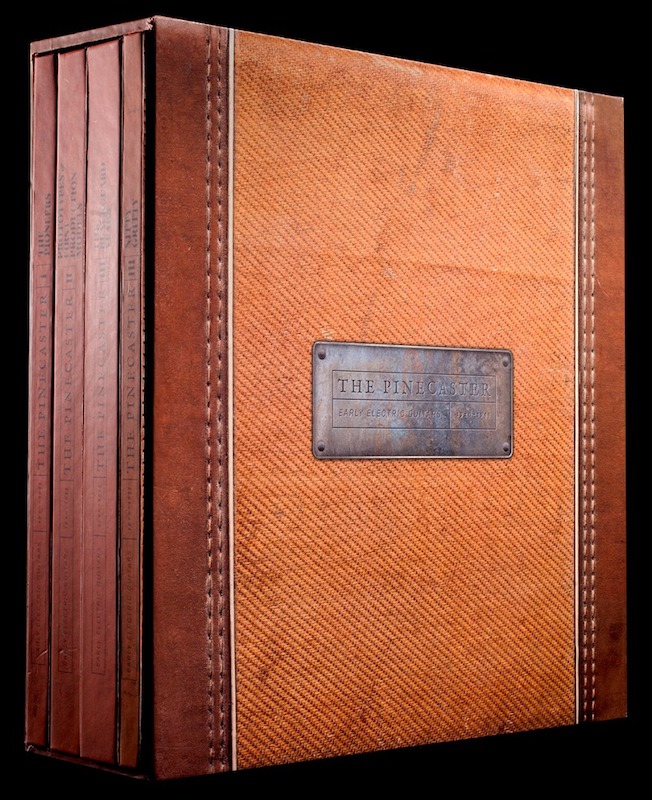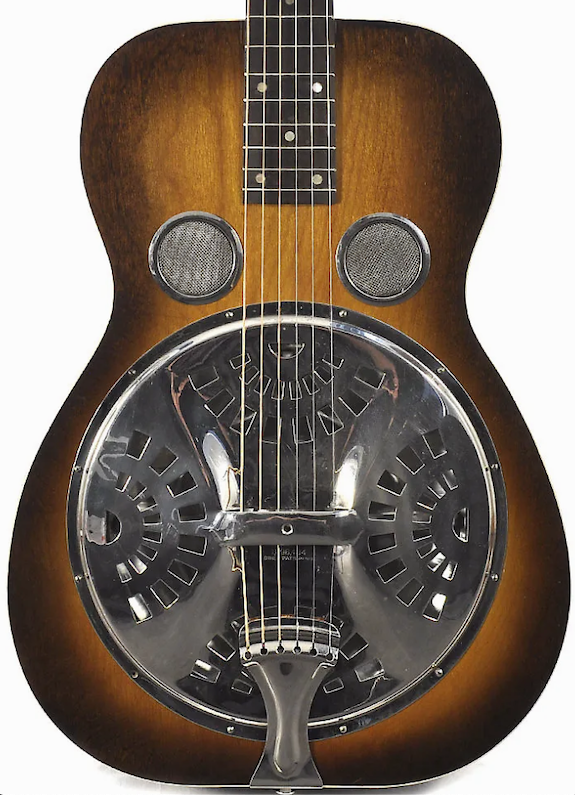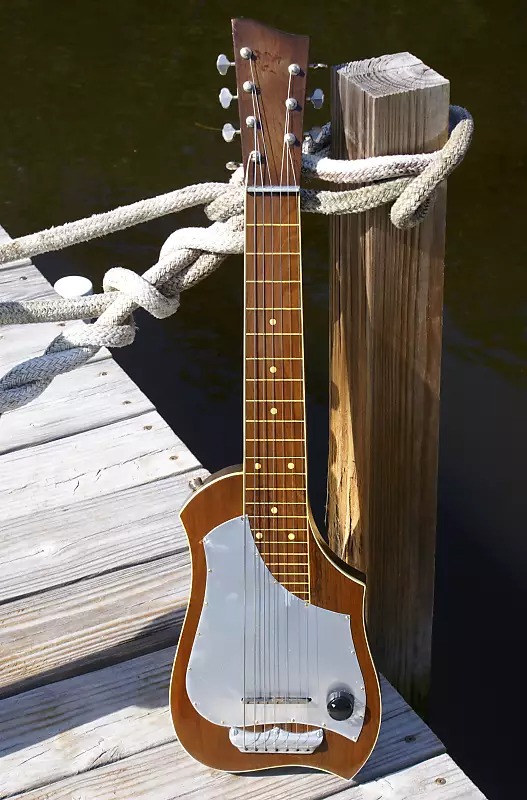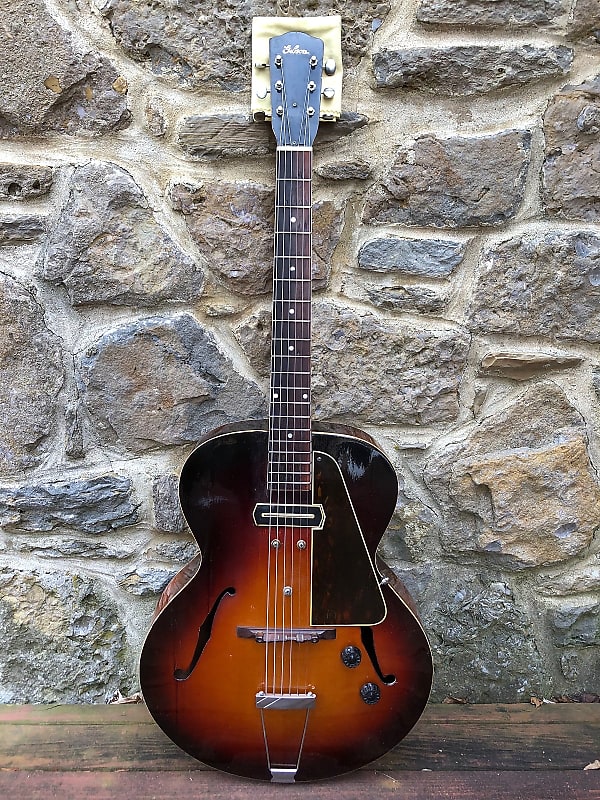Among the outstanding illustrations in the Pioneers section of The Pinecaster, a new boxed set of books by Nacho Banos and Lynn Wheelwright, there’s a page from a 1937 Montgomery Ward mail-order catalogue. It shows a couple of Gibson-made electrics, an archtop Spanish and a small-body Hawaiian, and its stirring headline—"Now the Man in The Last Row Can Hear"—sums up the way the developing revolution in electric guitars exploded in the mid ’30s.
Lynn Wheelwright explains further that the Recording King 1270 archtop in that ad preceded the start of production of Gibson’s ES-150, which has been customarily described as the company’s first Spanish electric guitar. In fact, the 1270 and a similar Old Kraftsman 8709 model for the Spiegel catalogue were, by a matter of weeks, Gibson’s first ES guitars off the line. As Lynn writes: "Not the iconic Gibson ES-150s of Charlie Christian fame, but rather a couple of cheaper second-cousins by the name of Recording King and Old Kraftsman."

It’s one of many revelations, big and small, in the mighty limited-edition Pinecaster package. It’s divided into four books that tell the story of Fender’s first electric guitars, covering the period from the ’20s to the mid ’50s, and also includes memorabilia repros, an app with video demos by Deke Dickerson and others, and artworks by Billy Gibbons.
Lynn’s Pioneers book explores the origins of the electric guitar in the ’20s and ’30s, and the three books that follow analyze in deep detail the way Leo Fender and his team drew upon those foundations to build their early Esquires, Broadcasters, and Telecasters (and before ash, yes, there was some pine).
Lynn is abundantly qualified to present such a story. He’s a tireless researcher and collector who seeks written records, factual evidence, and real examples of the instruments concerned in order to determine a true timeline and identify the key people and companies.
It all began nearly 40 years ago when he met the guitarist Alvino Rey, who he describes as the king of the electric guitar in the ’30s, a time when Gibson hired Alvino to help with the firm’s early electric experiments. Not only did Lynn become Alvino’s guitar tech, but also he sensed an opportunity.
"I could actually talk to the man who helped start this evolution and this revolution," he tells me. "I could listen to his stories, find out what he did, look through his scrapbooks. It made me feel that here was something I really needed to do—to put together the most complete collection ever of early electric instruments. Of course, I had no road map back then—few books, and no internet. I just had to walk through the dark and stumble on stuff."

During the years that followed, he’s brought some impressive stuff into the light and assembled a unique collection. "I’ve tried and largely succeeded to find the earliest example of these things, and then subsequent examples, to be able to forensically examine them and find out how they work."
He owns the third or fourth ever Rickenbacker and the earliest Gibson electric he could find, which he’s pretty sure is the prototype. "The earliest Epiphone, too, and the earliest Dobro All-Electric. I have early Regal things, Kay, Vega, and the earliest Vivi-Tone that I know of, a viola. I own almost the first electric instrument known by every company that existed, and then subsequent examples."
A viola, did you say? It’s an important point. As Lynn amassed his collection, he didn’t care if the instruments were guitars or mandolins or violins. "Because it wasn’t about the ‘frame’ that held the pickup," he explains. "I was interested in the technology and the evolution and design of the pickup." In Lynn’s story, the pickup’s the thing. "Because that’s all an electric guitar is. You can stick a pickup on a two-by-four, carve it into a neck, and you’ve got an electric guitar."

There’s another division of types that befuddles him. "Why do people put an electric Spanish and an electric Hawaiian in different groups, with the Hawaiian always ending up as the ‘it ain’t a guitar’ subgroup? It’s a solidbody electric guitar, damn it! And it doesn’t take much to turn that thing 90 degrees and play it like a Spanish guitar. My retort is always: ‘It’s the technology, stupid.’ A pickup can be put in anything."
One of the earliest electric instruments Lynn has evidence for is what he describes as a rudimentary electric synth violin, the brainchild of one Frederick W. Dierdorf of Rochester, NY. Frederick drew a rough design in 1922 and filed a patent two years later, but after various attempts to interest manufacturers, his story ended in court.
"In 1943," Lynn says, "in an attempt to defend his rightful place in history, he filed a lawsuit against the behemoth of the industry, Gibson, Inc. He was broke and representing himself, and the court transcripts read like a tragic comedy. Facing Gibson’s experienced law firm, he was soundly defeated."
Frederick’s original patent pre-dates the earliest electric guitar designs detailed in the Pioneers book, which kick off in the late ’20s and early ’30s with Stromberg-Voisinet (later Kay), Vivi-Tone, and Ro-Pat-In/Electro String/Rickenbacker. It’s at this time that we meet the remarkable George Beauchamp. He’s the man Lynn nominates when I ask for the most significant innovator and company in this story of groundbreaking electric stringed instruments. "George and Electro String designed, manufactured, and successfully marketed the earliest known direct string-actuated electromagnetic transducer," he says.
Next in line would be Dobro, in 1933. "That’s for redesigning the pickup—which, by the way, was hum-canceling—so that the magnet was out of the player’s way. After that, it has to be whoever designed the 1935 Regal pickup, just an amazing futuristic work of engineering genius."

And, of course, Gibson. "Once Gibson had made sure the waters were safe, they supercharged the interest in electric guitars with their production capability and formidable sales force. And as much as I appreciate Lloyd Loar and his designs for Vivi-Tone, they were just a bit too far out in left field, and a bit cumbersome when compared to the Beauchamp and Dobro designs."
If the Pioneers book and its discussion of National, Audiovox, Slingerland, Harmony and the rest whets your appetite for something a little more unusual than yet another flamey Les Paul, it’s not impossible to pick up for yourself some of these artifacts from the dawn of the electric era. "You can buy a good ’30s lap steel for the price of a good Ibanez. Not a big deal," Lynn says. An electric Spanish from the ’30s, however, would be significantly more expensive and harder to find.
Some of the videos in the Pinecaster set feature Julian Lage, who played through Lynn’s collection with a recurring comment. "Julian would say how wonderful the instruments were, and he kept asking, ‘Why don’t they make these any more?’ I thought: Well, because time moves on, and tastes change. There are a number of independent luthiers and builders still making examples of the ES-150, but nobody even cares about the Dobro design, or especially the Regal design—which is the one that just knocks my socks off," he says. "And I guess that’s because of their relative obscurity. In the case of the Regal, for example, there’s only two examples of that guitar that exist. And I own ‘em both!"
If you’re attracted by these instruments enough to want to find some, Lynn advises that you should set a focus. "Do you want things that are historically important? Do you want to collect them to play them? Do you want to have cool ’30s electric art hanging on the wall? Do you want to explore the technology, like I did? Do a little research, read some books, look online," he suggests, "and decide what you’re trying to accomplish."

The easiest place to start in early electrics is probably with Gibson, simply because they were the most prolific. "But if you’re interested, like I was, in the evolution and design, you’ve got to move into the obscure," Lynn says. "As I say, it was my goal from when I first started this, a million years ago, to find the earliest example of every electric instrument produced. Because I thought if you’re going to study the evolution and development, you need to start at ground zero. In the middle doesn’t work."
Old technology is hitting the radars of a fresh generation, Lynn says. It’s becoming cool. Maybe it’s a good time for a new interest in pioneering electric instruments? "Early computer technology, Apple and so on, and Edison stuff, early electronic experiments, Tesla coils—these are all being reconsidered and revalued. People are finally giving them the importance they deserve in history."
For a long time, Lynn was baffled that nobody cared about early electric guitars. Looking back now, he knows why. Simply because they weren’t worth anything. "When I used to go to guitar shows through the ’80s and ’90s, I would ask dealers: ‘What have you got that’s ‘30s electric?’ If they had anything at all, they’d say it was back at the shop, because it wasn’t worth anything—it wasn’t worth taking space in the van. It was that red-headed stepchild that just wasn’t worth having around. But if it wasn’t for the red-headed stepchild, the Lake Placid Blue Strat wouldn’t exist."
More info on The Pinecaster boxed set at pinecasterbook.com.
About the Author: Tony Bacon writes about musical instruments, musicians, and music. His books include Million Dollar Les Paul and Electric Guitars: Design & Invention. Tony lives in Bristol, England. More info at tonybacon.co.uk.
